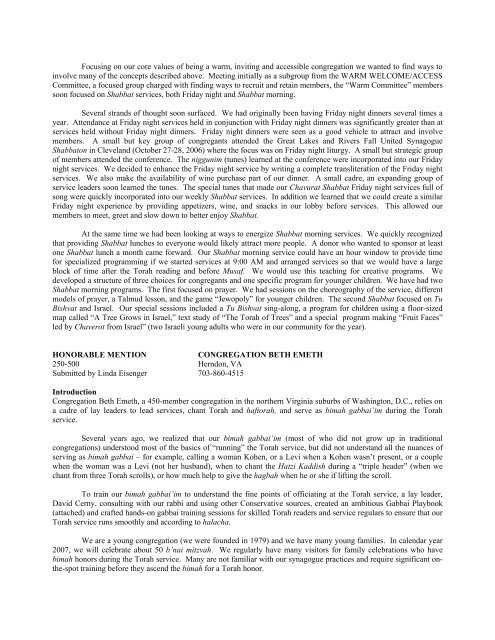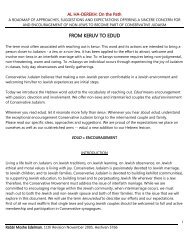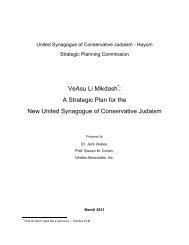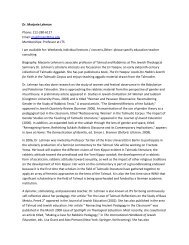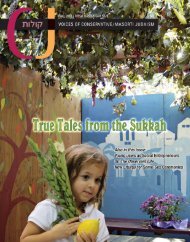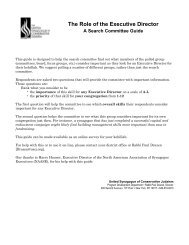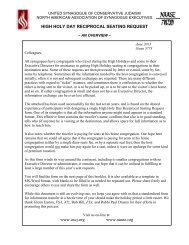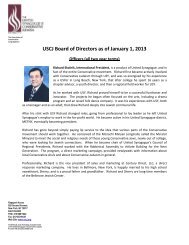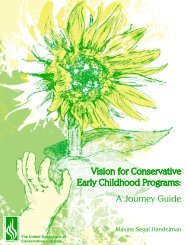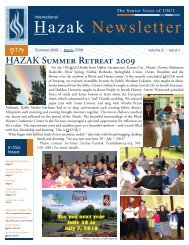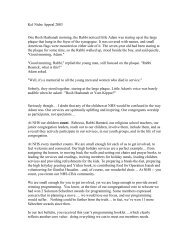2007 - United Synagogue of Conservative Judaism
2007 - United Synagogue of Conservative Judaism
2007 - United Synagogue of Conservative Judaism
Create successful ePaper yourself
Turn your PDF publications into a flip-book with our unique Google optimized e-Paper software.
Focusing on our core values <strong>of</strong> being a warm, inviting and accessible congregation we wanted to find ways to<br />
involve many <strong>of</strong> the concepts described above. Meeting initially as a subgroup from the WARM WELCOME/ACCESS<br />
Committee, a focused group charged with finding ways to recruit and retain members, the “Warm Committee” members<br />
soon focused on Shabbat services, both Friday night and Shabbat morning.<br />
Several strands <strong>of</strong> thought soon surfaced. We had originally been having Friday night dinners several times a<br />
year. Attendance at Friday night services held in conjunction with Friday night dinners was significantly greater than at<br />
services held without Friday night dinners. Friday night dinners were seen as a good vehicle to attract and involve<br />
members. A small but key group <strong>of</strong> congregants attended the Great Lakes and Rivers Fall <strong>United</strong> <strong>Synagogue</strong><br />
Shabbaton in Cleveland (October 27-28, 2006) where the focus was on Friday night liturgy. A small but strategic group<br />
<strong>of</strong> members attended the conference. The niggunim (tunes) learned at the conference were incorporated into our Friday<br />
night services. We decided to enhance the Friday night service by writing a complete transliteration <strong>of</strong> the Friday night<br />
services. We also make the availability <strong>of</strong> wine purchase part <strong>of</strong> our dinner. A small cadre, an expanding group <strong>of</strong><br />
service leaders soon learned the tunes. The special tunes that made our Chavurat Shabbat Friday night services full <strong>of</strong><br />
song were quickly incorporated into our weekly Shabbat services. In addition we learned that we could create a similar<br />
Friday night experience by providing appetizers, wine, and snacks in our lobby before services. This allowed our<br />
members to meet, greet and slow down to better enjoy Shabbat.<br />
At the same time we had been looking at ways to energize Shabbat morning services. We quickly recognized<br />
that providing Shabbat lunches to everyone would likely attract more people. A donor who wanted to sponsor at least<br />
one Shabbat lunch a month came forward. Our Shabbat morning service could have an hour window to provide time<br />
for specialized programming if we started services at 9:00 AM and arranged services so that we would have a large<br />
block <strong>of</strong> time after the Torah reading and before Musaf. We would use this teaching for creative programs. We<br />
developed a structure <strong>of</strong> three choices for congregants and one specific program for younger children. We have had two<br />
Shabbat morning programs. The first focused on prayer. We had sessions on the choreography <strong>of</strong> the service, different<br />
models <strong>of</strong> prayer, a Talmud lesson, and the game “Jewopoly” for younger children. The second Shabbat focused on Tu<br />
Bishvat and Israel. Our special sessions included a Tu Bishvat sing-along, a program for children using a floor-sized<br />
map called “A Tree Grows in Israel,” text study <strong>of</strong> “The Torah <strong>of</strong> Trees” and a special program making “Fruit Faces”<br />
led by Chaverot from Israel” (two Israeli young adults who were in our community for the year).<br />
HONORABLE MENTION<br />
CONGREGATION BETH EMETH<br />
250-500 Herndon, VA<br />
Submitted by Linda Eisenger 703-860-4515<br />
Introduction<br />
Congregation Beth Emeth, a 450-member congregation in the northern Virginia suburbs <strong>of</strong> Washington, D.C., relies on<br />
a cadre <strong>of</strong> lay leaders to lead services, chant Torah and haftorah, and serve as bimah gabbai’im during the Torah<br />
service.<br />
Several years ago, we realized that our bimah gabbai’im (most <strong>of</strong> who did not grow up in traditional<br />
congregations) understood most <strong>of</strong> the basics <strong>of</strong> “running” the Torah service, but did not understand all the nuances <strong>of</strong><br />
serving as bimah gabbai – for example, calling a woman Kohen, or a Levi when a Kohen wasn’t present, or a couple<br />
when the woman was a Levi (not her husband), when to chant the Hatzi Kaddish during a “triple header” (when we<br />
chant from three Torah scrolls), or how much help to give the hagbah when he or she if lifting the scroll.<br />
To train our bimah gabbai’im to understand the fine points <strong>of</strong> <strong>of</strong>ficiating at the Torah service, a lay leader,<br />
David Cerny, consulting with our rabbi and using other <strong>Conservative</strong> sources, created an ambitious Gabbai Playbook<br />
(attached) and crafted hands-on gabbai training sessions for skilled Torah readers and service regulars to ensure that our<br />
Torah service runs smoothly and according to halacha.<br />
We are a young congregation (we were founded in 1979) and we have many young families. In calendar year<br />
<strong>2007</strong>, we will celebrate about 50 b’nai mitzvah. We regularly have many visitors for family celebrations who have<br />
bimah honors during the Torah service. Many are not familiar with our synagogue practices and require significant onthe-spot<br />
training before they ascend the bimah for a Torah honor.


